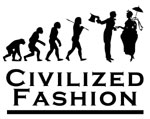Men's Portrait Gallery
1880
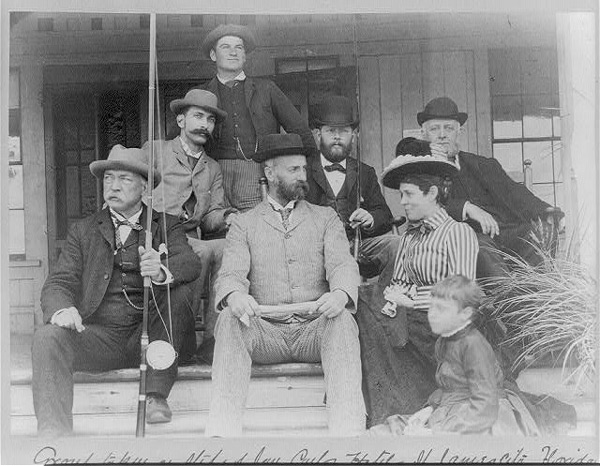
A day at the Lake
These gentlemen, who appear to be on holiday, display the variety of styles available to men in the 1880’s. The gentleman in the front center displays the most popular style of closely tailored sack suit with a wingtip collar and four in hand tie.
While the other suits are in a variety of colors and fabrics, they all show evidence of the narrow lapel, and tightly fitted clothing. Ties were still available in the bow tie style and, as seen on the gentleman with the fishing pole, tied with a small ribbon. All manner of hats are on display in this picture and highlight the variety available during this decade.
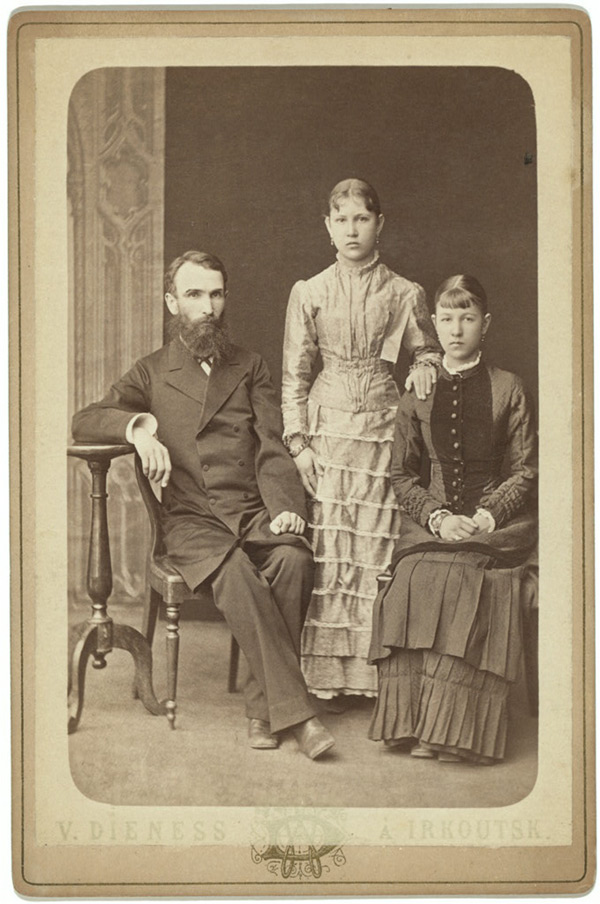
Family Portrait
As can be seen in this photograph of a father and his two daughters, frock Coats were still worn by older, more well-heeled gentlemen. While his frock coat is more loosely tailored than the sack suits above, it is clearly more fitted than the popular styles of the 1860’s. Despite his full beard, a stylish narrow necktie be seen at his collar.

Ready for the World
This gentleman's well tailored outfit highlights many of the fashions of the 1880s. Note the extremely narrow lapel on the sack coat, the high button front and the curved front of the jacket. His trousers are also tailored to a more slim style, note that there are still no creases in the front of his trousers as the press had not yet been invented. He wears his coat buttoned only at the top to proudly display his vest and watch chain.
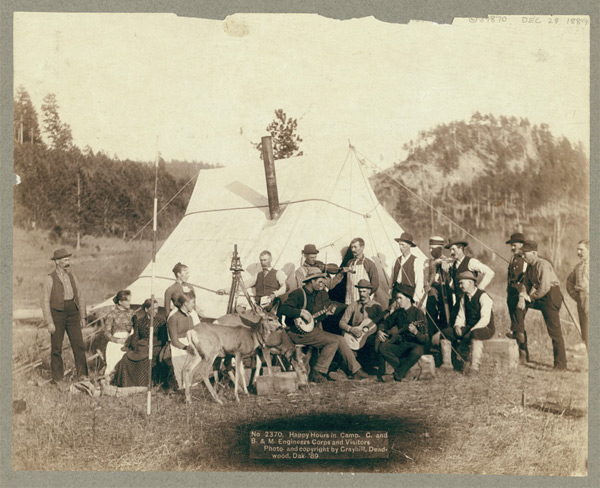
Happy Hour in Deadwood
Gather round to hear the tales of the day and sing a few songs to pass the time. On display in this portrait is the day wear of the settlers and workers in the western territories. Note the absence of coats on all of the gentlemen, but most still wear a vest and tie. The variety of hats is impressive. But, one wonders, why were the deer invited?
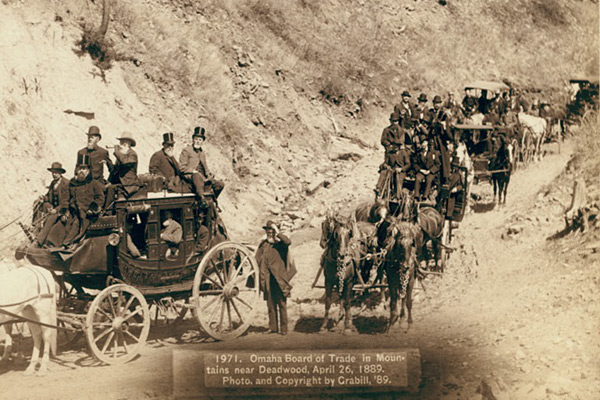
Board of Trade
Arrives in Deadwood
In contrast to the working men above, the Bankers arrive in Deadwood in full dress attire. The fancy high top hats and fashionable frock coats with contrast collars show that these are men of means, even if they are on the outside of the stagecoach. Note the gentleman in the first stagecoach with his enormous smoking pipe.
What did men wear in the 1880s?
Men in the 1880s wore clothing characterized by higher necklines and slimmer silhouettes. Their typical attire included cutaway coats or sack coats with high-buttoning necklines, matching or contrasting vests (waistcoats), narrower trousers, white or patterned shirts with detachable collars and cuffs, and neckties such as four-in-hand or flat scarfs. Headwear consisted primarily of derby/bowler hats for business, with formal occasions calling for tailcoats and silk top hats.
What clothing was popular in the 1880s for men?
Popular men's clothing in the 1880s included the increasingly common three-piece sack suits for business and daily wear, cutaway coats which had replaced frock coats as the standard for business attire, Norfolk jackets for country and sporting activities, and specialized sportswear for new leisure pursuits. Knickerbockers (knee-length breeches) gained popularity for sports like hunting, golfing, and bicycling, while the emerging tuxedo began challenging the traditional tailcoat for evening events by the end of the decade.
What did upper class men wear in the 1880s?
Upper class men in the 1880s wore impeccably tailored garments made from the finest materials, with multiple outfits for different times of day and occasions. Their wardrobe typically included formal frock coats for the most formal daytime events, cutaway coats for business and social calls, and tailcoats for evening functions. Their shirts featured fine linens with detachable collars and cuffs, luxurious waistcoats (sometimes in silk brocades for evening wear), and accessories like gold pocket watches, silk top hats, and fine leather boots, sometimes adorned with spats. The wealthiest could afford specialty items like smoking jackets, which could cost the equivalent of $368-$768 in today's currency.
MORE Q&A
What did lower class men wear in the 1880s?
Lower class men in the 1880s wore practical, durable clothing focused on function rather than fashion. Factory workers, farmers, and laborers typically owned fewer garments, often just one outfit for work that would be patched and repaired repeatedly. Their clothing consisted of basic work shirts (sometimes without the luxury of detachable collars), sturdy trousers, practical vests made of denim or heavy twill, and simple sack coats or older-style jackets. For headwear, soft caps were more common than the bowler hats of the middle class or top hats of the upper class. As seen in frontier photos, even in remote areas men followed general clothing conventions but in much simpler, well-worn versions.
Is Historical Emporium 1880s Men's Clothing good quality?
Historical Emporium offers well-crafted reproductions of 1880s men's clothing that balance historical accuracy with modern wearability. Their garments feature period-appropriate styles, cuts, and details while incorporating contemporary construction techniques for comfort and durability. The company provides a full line of men's period clothing suitable for movie and TV production, theatrical performances, living history events, and vintage-themed weddings, with individual pieces available to create authentic 1880s ensembles.
What types of coats did men wear in the 1880s?
Men in the 1880s wore several types of coats: the cutaway (morning) coat became the standard for business and leisure, replacing the more formal frock coat which was reserved for the most formal daytime occasions; the sack coat gained significant popularity as part of matching three-piece suits for business wear; the Norfolk jacket with its belted waist and pleated back was favored for country wear and sporting activities; and overcoats such as the Chesterfield, Inverness, and Ulster (often with capes) provided protection in inclement weather.
What were men's trousers like in the 1880s?
Men's trousers in the 1880s were narrow and more closely fitted than in previous decades, featuring button flies and typically high waists. While darker colors in both solid and striped patterns were common, trousers often did not match the coat and vest, with fashion plates showing men combining light colors or brightly striped pants with darker coats. For sporting activities, baggy knickerbockers (knee-length breeches) became increasingly popular among hunters, golfers, and bicyclists due to their lighter weight and ease of movement.
MORE Q&A
What shirts and collars did men wear in the 1880s?
Men's shirts in the 1880s were made of cotton or linen in stripes, patterns, or white, with technological advances allowing for more colors in a single pattern. Most shirts still featured the pullover style, though button-front shirts began appearing despite some fashion critics' disdain. Detachable collars and cuffs were standard, especially for office workers, as they could be more easily and inexpensively laundered than entire shirts. The detachable shirt bosom or "dickey" also gained popularity among office workers as an economical way to transform a work shirt into evening attire.
What neckwear was fashionable for men in the 1880s?
Men's neckwear in the 1880s primarily consisted of knotted scarfs (ties) worn in several styles. The "flat scarf" (or Puff Tie) was preferred for high-collared vests to reduce bulk, while the four-in-hand style could be tied in loose or tight knots according to personal preference. The width of the four-in-hand varied seasonally, being narrower in summer and wider in winter. As with other aspects of 1880s men's fashion, these ties complemented the decade's trend toward higher necklines and more formal, streamlined silhouettes.
What hats did men wear in the 1880s?
The derby/bowler hat became the most common headwear for men in the 1880s, especially for business attire worn with sack coats or cutaways. Hat heights increased throughout the decade, and dark colors dominated to match the somber tones of suits. The stiffer Homburg hat gained popularity partly due to the Prince of Wales being seen wearing the style. For sports and summer wear, straw boaters and soft caps were popular options, though light-colored hats were only acceptable during summer months and not to be worn after September 15th in fashionable society.
What did men wear for formal evening occasions in the 1880s?
For formal evening occasions in the 1880s, men primarily wore black tailcoats with satin inset lapels and roll or shawl collars, paired with matching double-breasted waistcoats featuring low U-front openings. White pleated or ruffled-front dress shirts, white silk bow ties, and matching narrow-legged trousers completed the ensemble, topped with a silk hat (often the collapsible Gibus model for theater events). By the end of the decade, the dinner jacket or "tuxedo" began emerging as a less formal alternative, featuring a shorter black coat with a shawl collar and up to two buttons.
MORE Q&A
How did the tuxedo originate in the 1880s?
The tuxedo originated in the 1880s as an alternative to the traditional tailcoat for evening wear. Though accounts vary, the name "tuxedo" is commonly attributed to the 1886 Autumn Ball in Tuxedo Park, NY, where either Pierre Lorillard (a young socialite) appeared with the tails removed from his formal coat, or a group of young men arrived in tailless coats with bright red vests. Initially, the tuxedo was black with a shawl collar and featured zero to two buttons, worn with the same accessories as a tailcoat. The style gained popularity through the decade and would eventually become the dominant form of men's formal evening wear.
What did men wear for sports and leisure in the 1880s?
For sports and leisure in the 1880s, men wore specialized attire designed for comfort and freedom of movement. The Norfolk jacket, with its belted waist and pleated back, was popular for hunting, fishing, and bicycling activities. Knickerbockers (baggy knee-length breeches) replaced full-length trousers for many sporting pursuits. For summer sports like lawn tennis, rowing, and boating, single-breasted and brightly striped sack jackets were fashionable, while the double-breasted Reefer jacket was another option for summer leisure. These outfits often omitted the vest, one of the few contexts where men might forgo this otherwise essential garment.
How did social class influence men's fashion in the 1880s?
Social class significantly influenced men's fashion in the 1880s, when the growing middle class of clerical workers (secretaries, bookkeepers, and managers) had sufficient income to spend on consumer goods and fashion. This new middle class embraced the three-piece sack suit as their standard business attire, while the working class prioritized durability and function in their clothing choices. The decade saw the expansion of ready-to-wear options making fashionable clothing more accessible across class lines, though quality of materials, tailoring precision, and the ability to own multiple outfits for different occasions still clearly demarcated social boundaries.
What did cowboys and frontier men wear in the 1880s?
Cowboys and frontier men in the 1880s wore practical clothing adapted to their demanding lifestyle and environment. Their attire typically included durable work shirts, vests for extra pockets and warmth, sturdy trousers (increasingly including denim jeans after their introduction in the 1870s), and protective outerwear like dusters or slickers. Wide-brimmed hats provided essential protection from the elements, while sturdy boots with high tops protected against brush and snakes. As evidenced in frontier photos, these men followed general clothing conventions but prioritized durability and function, with clothing showing signs of heavy use and practical adaptations.
MORE Q&A
How did men's fashion change from the 1870s to the 1880s?
Men's fashion from the 1870s to the 1880s evolved primarily through higher necklines and even slimmer silhouettes. Coat necklines rose so high they often revealed merely a glimpse of shirt and vest, with vest collars rising correspondingly. The cutaway coat replaced the frock coat as standard business attire, while the three-piece sack suit gained significant popularity. Specialized sportswear emerged for various leisure activities, reflecting the growing middle class's interest in recreation. The most significant innovation was the introduction of the tuxedo in the late 1880s, which would eventually challenge the tailcoat's dominance for formal evening wear.
Want to learn more? Visit our 1880s Mens Fashion Guide.









